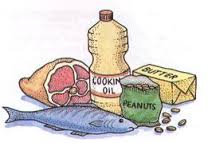FAT. It’s not such a nice word and it gets thrown around a lot. As humans we eat fat, we store fat, the words has even become an adjective used by many to describe others’ bodies. But, like much else around us, fat just comes down to simply being a group of different atoms bonded together to form certain types of molecules.
The correct term for the ‘fatty’ group of molecules is LIPIDS. And we break lipids into 3 wider groups; triglycerides, phospholipids and sterols.
Triglycerides
Triglycerides are the family of lipids most predominant in food and in our bodies. They consist of fats and oils. Fats are typically solid at room temperature while oils are typically liquid at room temperature. They are characterised by a glycerol ‘head’ attached to 3 fatty-acid ‘tails’.
[The zig-zags indicate CH2 links along the fatty acid tail]
There is a lot of talk about fatty acids and the types of fatty acids found in certain foods (getting to that later). However, it is important to note that fatty acids are rarely found in nature, or in the body, as free molecules – they exist in this way, bonded to glycerol.
Fatty Acids can have anywhere from 4 – 24 carbon atoms in their carbon chain, and always an even number.
- ‘short-chain fatty acids’ have less than 6 carbon atoms,
- ‘medium-chain fatty acids’ have 6-10 carbon atoms while
- ‘long chains’ have 12-24 carbons.
Fatty acids will have anywhere from none, one or many double bonds. The number and type of double bonds in the fatty acid determines the 4 major groups of fatty acids; Saturated, Monounsaturated, Polyunsaturated and Trans Fatty Acids. These characteristics also affect the way they are processed in our bodies.
Saturated Fatty Acids (SFAs)
Saturated fatty acids contain no double bonds, they are very stable and typically solid at room temperature.
Foods high in saturated fatty acids include butter, coconut oil, palm oil, meat and meat fats (lard, tallow etc).
Monounsaturated Fatty Acids (MUFAs)
Monounsaturated fatty acids contain only 1 double bond.
Foods with MUFAs include olive oil, canola oil, peanut oil, avocado, nuts and seeds.
Polyunsaturated Fatty Acids (PUFAs)
Polyunsaturated fatty acids contain 2 or more double bonds.
Foods containing PUFAs include walnuts (and walnut oil), flaxseeds (and flax oil), safflower oil, sunflower oil, corn oil, soybean oil, cottonseed oil and oily fish.
PUFAs are further categorised according to where the first double bond appears along the carbon chain. They are named by the carbon at which the first double bond appears from the methyl end. The methyl end is known as the ‘omega’ end. So a PUFA like linoleic acid above is known as an Omega-6 fatty acid because the first double bond appears at the 6th carbon atom from the omega end. Omega-3 fatty acids have their first double bond appear at the 3rd double bond from the methyl end. The most important omega-6 and omega-3 fatty acid family members are those with 18, 20 and 22 carbons.
EPA and DHA are omega-3 fatty acids with 20 and 22 carbon chain lengths and are very important for brain function, immune system, vision, cell regulation, platelet aggregation, smooth muscle contraction and much more. Similarly the omega-6 acids of longer chain length are crucial for our body to function.
Our bodies are very clever pieces of work and are able to build many things including manufacturing triglycerides when not received in our diet. However, we are unable to create double bonds at the 3rd or 6th carbons in these fatty acid chains! So if we do not eat enough omega-3 or omega-6 fatty acids then we are unable to manufacture them. We can though, extend the length of an existing omega-6 or omega-3 chain.
The term “essential fatty acid” is used for linoleic acid and alpha-linolenic acid (below). These are the first omega-6 and omega-3 fatty acids in their families, with 18 carbons. These are essential to include in the diet so that we can manufacture the longer C20, C22, C24 fatty acids in the omega families. This manufacture is still energy intensive and the best wayto ensure our bodies have an adequate supply is to eat foods rich in ALL omega-3 and omega-6 fatty acids. Fish and seafood is the absolute best source of the longer EPA and DHA chains.
While we talk about these types of fatty acids and the foods in which they’re found it’s important to note that all foods will contain a MIXTURE of these different types of fatty acids, as per above image.
Trans Fatty Acids
Trans fatty acids are found to a very small extent in dairy and some meat products but are not natural. The predominant around of trans fatty acids are formed when PUFAs are hydrogenated or heated in food manufacturing – that is, making the polyunsaturated fats more saturated. However, rarely are these PUFAs fully saturated in the process and what happens is the formation of another double bond, oriented in a different way.
See how in the photo below, the double bond makes the fatty acid LOOK like a saturated fatty acid, but it really still has a double bond? Compare this to the picture of oleic acid above where the double bond is more like a ‘C’ shape (this is called a cis- double bond which is most natural).
This type of double bond causes the fatty acid to have properties of saturated fatty acids (for example they are solid at room temperature – margarine is just hydrogenated vegetable oil), including the way they are processed in the body which is a bit of a nasty trick and not great for our health!
Phospholipids
Phospholipids are very similar to triglycerides. They have a glycerol head with 3 tails. However, a phospholipid contains 2 regular fatty acid chains and 1 phosphate chain. As per below diagram.
The best known phospholipid is lecithin, found in eggs, liver, soybeans, wheat germ and peanuts. The phosphate end makes the molecule polar, with a slight charge at each end. This is very important as it enables the glycerol head to be soluble in water (hydrophilic) while the tails are hydrophobic and attracted to other fats. This property means that phospholipids are a key component in helping to overcome the fact that oil and water don’t mix! They act as emulsifiers in our bodies helping to digest and transport fats and fat-soluble vitamins, minerals and hormones through our water-rich bodies, acting like a ‘cell membrane’ to transport the components around the body.
The food industry use phospholipids as emulsifiers to mix fats with water in such products as mayonnaise and snack bars.
Sterols
Sterols are a fat with the form of 4 carbon rings. Cholesterol is the principle sterol and is found in animal foods.
We absorb less than 30% of the cholesterol we eat and dietary cholesterol has very little impact on heart disease. Our bodies manufacture 800-1500mg cholesterol daily whereas we generally consume 300-450mg (and remember that less than 30% of this is actually absorbed). Cholesterol is essential for the manufacture of many steroid hormones including testosterone, oestrogen, cortisol, as well as bile acids and vitamin D.
Plants also contain sterols and interestingly, these sterols interfere with the absorption of cholesterol as they have similar structures!
Sterols and Phospholipids make up less than 5% of dietary lipid intake and are not essential nutrients as the body is able to manufacture them.
Stay tuned for more info on how we DIGEST AND ABSORB fats in our bodies, including a discussion on the ‘good’ HDL cholesterol and ‘bad’ LDL cholesterol!








